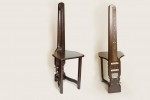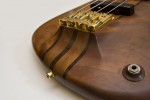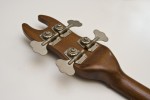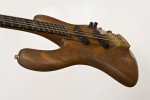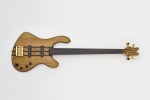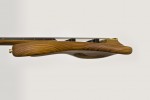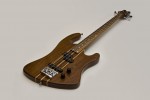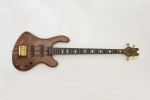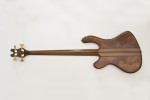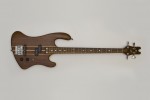History
(1979-1993)
Rüdiger Ziesemann builds his first basses during his apprenticeship as a carpenter in his parents‘ house in Kempen on the Lower Rhine. In 1982 he turns his hobby into his profession and opens his first bass shop by the name of “Bass & Spass” (bass and fun). As a newcomer in making instruments he cannot earn a living and consequently sets up the joinery “Legno” in Krefeld-Hüls with three other carpenters. Besides working for his craftsmanship examination Ziesemann privately makes instruments in low numbers and displays them for sale in a salesroom of 10 square meters on the Legno compound. At that time Günther Schreiber enters the sales room and suggests to him the idea of a line of guitars. “Delta-Guitars” with its polarising model “Teardrop” is born. In 1984 Ziesemann and Schreiber present their lines of instruments “Delta-Guitars” and “Bass & Spass” at the trade fair “Sound und Musik” in Essen for the first time. There Ziesemann also presents the prototype of his experimental bass-chair, “…at whose backrest the bass strings were fixed and which could be played while sitting down on it. By the enormous mass that such a chair possesses, emerges a most unlikely sustain, that I haven’t heard of an e-bass to date. …” (Horst Stachelhaus, professional magazine “Musikmagazin” 8/93)
Ziesemann impressed professional circles even before the actual launch of Bassline with unconventional methods in the course of the further development of instruments that can be ascribed to the light bulb moment evoked by the bigger mass of the bass chair neck.
Historie
(1993-1995)

Bassline is founded in the year 1993. Ziesemann decides to dedicate his professional life to making instruments and comes to the conclusion: “If professionally, then only with …” – meaning a CNC shaper that he places in his room on the Legno compound. At the same time he rents bigger rooms to present his instruments.
With the opening of his new rooms Ziesemann shows his first creations under the label “Bassline”. The solid model “Buster” with its elaborately glued neck is presented to the press for the first time and the press comes to the conclusion that “both basses represent the most advanced state of the art of making instruments”.
Ziesemann gives full scope to his hybrid basses that combine upright and a bass which you can carry around your shoulder – based on his experiences with the bass chair and presents his ideas to professional circles in 1994: “ The Bassline Universal “bass panels” are certainly the most unusual bass novelties (…)” Dirk Groll G&B 5/94. (…) nothing is strange to us. Almost nothing, anyway, because at the sight of today’s instruments the question arises: “What the hell is that supposed to be?” (…) I call that a real development in bass making.” (Soundcheck 10/1996, Jürgen Richter)
Historie
(1995-1997)
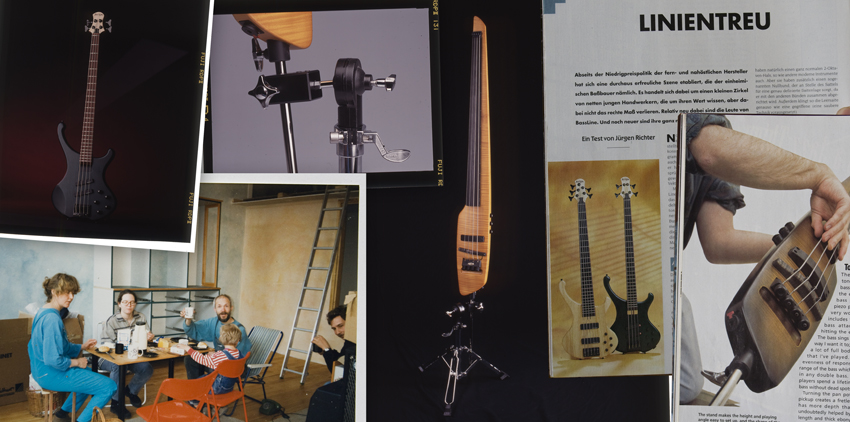
Parallel to the innovations for the Universal Ziesemann works on the long-established “Buster” and presents it with the “bolt on” version (a bolted neck) and thus paves the way to a wider public. Up to this day the Buster Classic with its ergonomical form is a bass much in demand.
After his exit from Legno Ziesemann modifies the form of the “Universal” in his new and bigger workshop in the street Mühlenweg in 1994. This is received with enthusiasm even in Great Britain: “… you wouldn’t believe how versatile the new generation of electric upright basses can be” (Bassist & bass techniques – UK, 2/97)
The Buster in a bolt-on version tested by Raoul Walton in the magazine „Soundcheck“ (2/1996)Historie
(1998-2000)
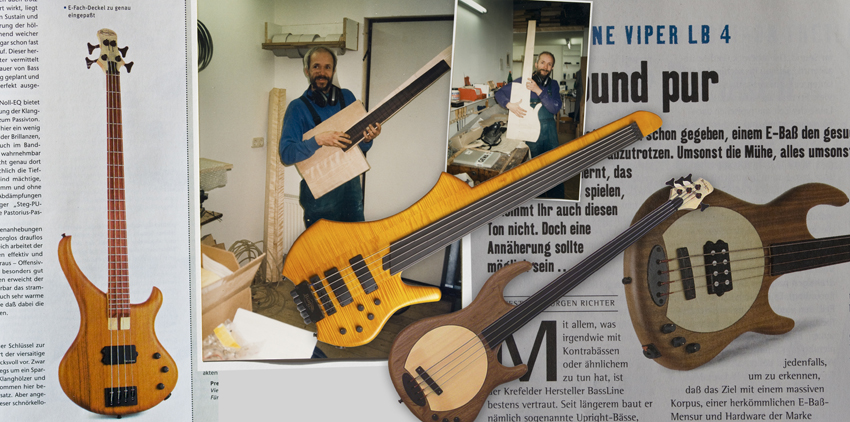
In 1998 the Buster’s body shaping is redesigned. Now it is a bit more modest. By using Dibetou wood for the body this bass weights only 3,2 kg and therefore is a real light weight.
Ziesemann caters for his customers‘ needs and turns the unusual neck of the “Universal” (“… an essential plus of sound satiety characterises the sustain” May 1994 professional magazine Musikmagazin”.) into a bass to hang around the shoulder with the help of glued on side parts. The “Worp” with its futuristic and polarising design is presented to the press in 1998 for the first time.
„(…) confronts you with a bass force that you simply wouldn’t expect from a wooden e-bass.” (…) “With the Worp ordinary bass players can enjoy Bassline’s broad neck technology for the first time. (…)” Bass Professor 4/98 Karsten Fernau)
While working on the Worp Ziesemann at the same time develops a concept to bring out the wooden acoustic sound of a contrabass from a fretless e-bass. With his ínnovative construction of a sound chamber with a capping cover of spruce and a glued on neck he succeeds in impressing professional circles with his new model “Viper”:
“The Viper by Bassline is a fretless bass of a special class. It is manufactured perfectly, very light in weight and has a wooden sound that I personally have never heard before. If you are looking for the independent sound, you should try the Viper by all means, especially as it reacts quite sensitively to the musician” // Jürgen Richter, Soundcheck 8/1998
Historie
(2000-2006)
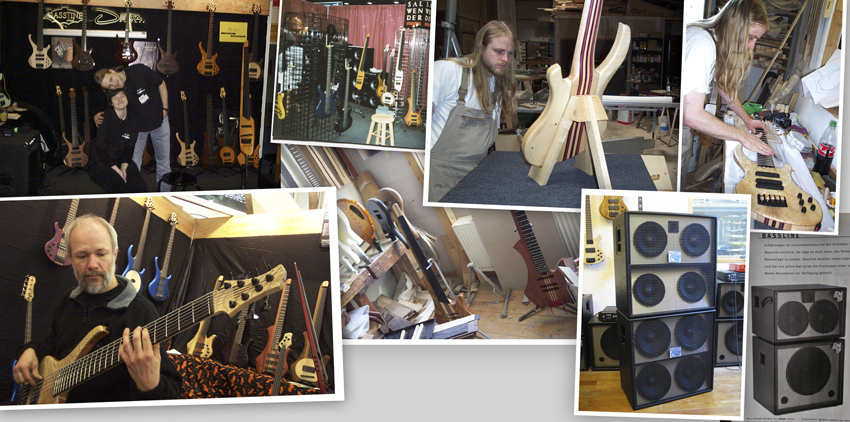
After an appeal for an apprentice in the professional magazine “Gitarre und Bass” (Guitar and Bass) in the year 2000 Fabian Wild is employed first as an intern and later on as an apprentice. With the completion of his journeyman’s piece in 2003 Fabian is the third permanent employee of the Bassline team. With Fabian’s help there is a lot of traditional carpentry under the label of “Holzdesign Ziesemann” (Wood Design Ziesemann) and several appearances at the Frankfurt trade fair with new Bassline basses like the Worp Art for example.
Between 2003 and 2006 Bassline develops and produces a small number of loudspeaker systems of its own “Chamäleon” series besides instruments. This series impresses with its new type of hinged front panel that makes it possible to adjust the radiation angle of the loudspeakers at one’s convenience.
“That Bassline treats its loudspeakers like it treats its instruments and works with the complex phenomena of their own sound produces the decisive plus of liveliness and intensity.” (Gitarre&Bass 10.2004, Dirk Groll)
Historie
(2006-2008)

In 2006 the Buster undergoes a fresh update. The model Buster CW (Custom Wood) makes it possible to cover different body timber with precious topwood. These basses have a “chambered body”. Thus it is possible to reduce their weight with recesses under the glued on covers. By using the different hues of different precious wood covers Bassline foregoes coloured paintwork to keep the natural charm of the wood.
“With its combination of woods the Buster offers an interesting sound mix of present sound response and massive foundation” (Gitarre und Bass 4.2009, Dirk Groll)
In 2007 the manufacture of instruments develops a new concept of the workshop “Pimp Your Bass” with Bassline endorser Andreas Reinhard. Once a month Rüdiger Ziesemann introduces a group of 5-6 interested musicians to the secrets of a perfectly adjusted instrument and offers tips and tricks around the maintenance of instruments.
At the beginning of 2006 Rüdiger Ziesemann opens his online shop “Bassparts” whose domain www.bassparts.de he has secured years before as a matter of prudence. Via this internet portal his wife Martina Ziesemann sells electronics by Klaus Noll and now exclusively hardware parts by ETS that Bassline has used since the late 90s. Via Bassparts interested customers from all over the world can purchase woods from the Bassline workshop, custom-made necks and bodies in all colours and forms as well as pickups of our partners like Delano, Häussel and Bassculture.
Historie
(2008-2012)
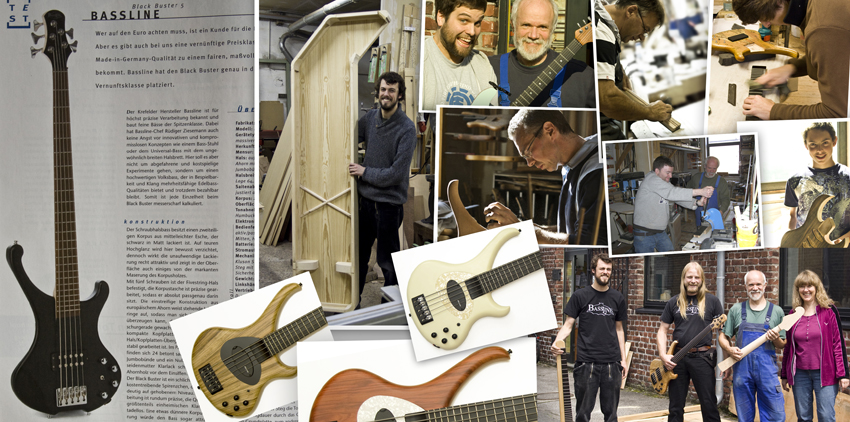
With the BlackBuster series Bassline pursues the goal of shaping its Buster with as few compromises as possible. Wrapped in matt black and equipped with an MM pickup this bass with its body of ash impresses with uncompromising price calculation without lowering the quality typical of Bassline products.
To build in the Xtender pickup by Delano in an visually attractive way in 2009 a small edition of basses was produced that equipped CWs in different wood combinations with a pickguard shaped like a plectrum.
In 2011 Bassline expands its range of workshops with another series and initiates the workshop “Build Your Bass”. Participants become a member of the Bassline team for an agreed amount of time and can build the instrument of their dreams under guidance.
In October 2011 the intern of 2003, Philipp Maike, becomes a permanent member of the Bassline staff. Meanwhile he has studied object design at the Krefeld University of Applied Sciences and makes parts of his diploma project in our workshop. Now he helps us not only in the workshop but also with our creative processes.
In the summer of 2012 the new Bassline homepage goes online.


